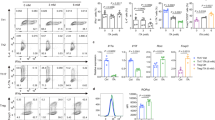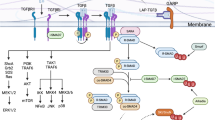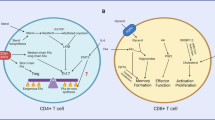Abstract
Interleukin-17 (IL-17)-secreting T cells of the T helper 17 (TH17) lineage play a pathogenic role in multiple inflammatory and autoimmune conditions and thus represent a highly attractive target for therapeutic intervention. We report that inhibition of acetyl-CoA carboxylase 1 (ACC1) restrains the formation of human and mouse TH17 cells and promotes the development of anti-inflammatory Foxp3+ regulatory T (Treg) cells. We show that TH17 cells, but not Treg cells, depend on ACC1-mediated de novo fatty acid synthesis and the underlying glycolytic-lipogenic metabolic pathway for their development. Although TH17 cells use this pathway to produce phospholipids for cellular membranes, Treg cells readily take up exogenous fatty acids for this purpose. Notably, pharmacologic inhibition or T cell–specific deletion of ACC1 not only blocks de novo fatty acid synthesis but also interferes with the metabolic flux of glucose-derived carbon via glycolysis and the tricarboxylic acid cycle. In vivo, treatment with the ACC-specific inhibitor soraphen A or T cell–specific deletion of ACC1 in mice attenuates TH17 cell–mediated autoimmune disease. Our results indicate fundamental differences between TH17 cells and Treg cells regarding their dependency on ACC1-mediated de novo fatty acid synthesis, which might be exploited as a new strategy for metabolic immune modulation of TH17 cell–mediated inflammatory diseases.
This is a preview of subscription content, access via your institution
Access options
Subscribe to this journal
Receive 12 print issues and online access
$209.00 per year
only $17.42 per issue
Buy this article
- Purchase on Springer Link
- Instant access to full article PDF
Prices may be subject to local taxes which are calculated during checkout




Similar content being viewed by others
Change history
31 October 2014
In the version of this article initially published online, the number 21.45, corresponding to the percentage of cells, was missing from the bottom right quadrant of the flow cytometry plot (SorA, WT) in Figure 2a. The error has been corrected for the print, PDF and HTML versions of this article.
References
Pearce, E.L., Poffenberger, M.C., Chang, C.H. & Jones, R.G. Fueling immunity: insights into metabolism and lymphocyte function. Science 342, 1242454 (2013).
Wang, R. & Green, D.R. Metabolic checkpoints in activated T cells. Nat. Immunol. 13, 907–915 (2012).
Chang, C.H. et al. Posttranscriptional control of T cell effector function by aerobic glycolysis. Cell 153, 1239–1251 (2013).
Barbi, J., Pardoll, D. & Pan, F. Metabolic control of the Treg/TH17 axis. Immunol. Rev. 252, 52–77 (2013).
Waickman, A.T. & Powell, J.D. mTOR, metabolism, and the regulation of T-cell differentiation and function. Immunol. Rev. 249, 43–58 (2012).
Shi, L.Z. et al. HIF1α-dependent glycolytic pathway orchestrates a metabolic checkpoint for the differentiation of TH17 and Treg cells. J. Exp. Med. 208, 1367–1376 (2011).
Dang, E.V. et al. Control of TH17/Treg balance by hypoxia-inducible factor 1. Cell 146, 772–784 (2011).
Michalek, R.D. et al. Cutting edge: distinct glycolytic and lipid oxidative metabolic programs are essential for effector and regulatory CD4+ T cell subsets. J. Immunol. 186, 3299–3303 (2011).
Lee, J. et al. Regulator of fatty acid metabolism, acetyl coenzyme a carboxylase 1, controls T cell immunity. J. Immunol. 192, 3190–3199 (2014).
Everts, B. et al. TLR-driven early glycolytic reprogramming via the kinases TBK1-IKKɛ supports the anabolic demands of dendritic cell activation. Nat. Immunol. 15, 323–332 (2014).
Wakil, S.J. & Abu-Elheiga, L.A. Fatty acid metabolism: target for metabolic syndrome. J. Lipid Res. 50 (suppl.), S138–S143 (2009).
Gerth, K., Bedorf, N., Irschik, H., Hofle, G. & Reichenbach, H. The soraphens: a family of novel antifungal compounds from Sorangium cellulosum (Myxobacteria). I. Soraphen A1α: fermentation, isolation, biological properties. J. Antibiot. (Tokyo) 47, 23–31 (1994).
Shen, Y., Volrath, S.L., Weatherly, S.C., Elich, T.D. & Tong, L. A mechanism for the potent inhibition of eukaryotic acetyl-coenzyme A carboxylase by soraphen A, a macrocyclic polyketide natural product. Mol. Cell 16, 881–891 (2004).
Vahlensieck, H.F., Pridzun, L., Reichenbach, H. & Hinnen, A. Identification of the yeast ACC1 gene product (acetyl-CoA carboxylase) as the target of the polyketide fungicide soraphen A. Curr. Genet. 25, 95–100 (1994).
Cho, Y.S. et al. Molecular mechanism for the regulation of human ACC2 through phosphorylation by AMPK. Biochem. Biophys. Res. Commun. 391, 187–192 (2010).
Zhou, L. et al. TGF-β–induced Foxp3 inhibits TH17 cell differentiation by antagonizing RORγt function. Nature 453, 236–240 (2008).
McGeachy, M.J. et al. The interleukin 23 receptor is essential for the terminal differentiation of interleukin 17–producing effector T helper cells in vivo. Nat. Immunol. 10, 314–324 (2009).
Abu-Elheiga, L., Matzuk, M.M., Abo-Hashema, K.A. & Wakil, S.J. Continuous fatty acid oxidation and reduced fat storage in mice lacking acetyl-CoA carboxylase 2. Science 291, 2613–2616 (2001).
Mao, J. et al. Liver-specific deletion of acetyl-CoA carboxylase 1 reduces hepatic triglyceride accumulation without affecting glucose homeostasis. Proc. Natl. Acad. Sci. USA 103, 8552–8557 (2006).
Abu-Elheiga, L. et al. Mutant mice lacking acetyl-CoA carboxylase 1 are embryonically lethal. Proc. Natl. Acad. Sci. USA 102, 12011–12016 (2005).
Delgoffe, G.M. et al. The mTOR kinase differentially regulates effector and regulatory T cell lineage commitment. Immunity 30, 832–844 (2009).
Wang, R. et al. The transcription factor Myc controls metabolic reprogramming upon T lymphocyte activation. Immunity 35, 871–882 (2011).
Dufort, F.J. et al. Glucose-dependent de novo lipogenesis in B lymphocytes: a requirement for ATP-citrate lyase in LPS-induced differentiation. J. Biol. Chem. 289, 7011–7024 (2014).
Menendez, J.A. & Lupu, R. Fatty acid synthase and the lipogenic phenotype in cancer pathogenesis. Nat. Rev. Cancer 7, 763–777 (2007).
Saggerson, D. Malonyl-CoA, a key signaling molecule in mammalian cells. Annu. Rev. Nutr. 28, 253–272 (2008).
Glatz, J.F., Luiken, J.J. & Bonen, A. Membrane fatty acid transporters as regulators of lipid metabolism: implications for metabolic disease. Physiol. Rev. 90, 367–417 (2010).
Martin, B.R. & Cravatt, B.F. Large-scale profiling of protein palmitoylation in mammalian cells. Nat. Methods 6, 135–138 (2009).
Ueda, A., Zhou, L. & Stein, P.L. Fyn promotes Th17 differentiation by regulating the kinetics of RORγt and Foxp3 expression. J. Immunol. 188, 5247–5256 (2012).
Shriver, L.P. & Manchester, M. Inhibition of fatty acid metabolism ameliorates disease activity in an animal model of multiple sclerosis. Sci. Rep. 1, 79 (2011).
Lee, P.P. et al. A critical role for Dnmt1 and DNA methylation in T cell development, function, and survival. Immunity 15, 763–774 (2001).
Berod, L. et al. PI3Kγ deficiency delays the onset of experimental autoimmune encephalomyelitis and ameliorates its clinical outcome. Eur. J. Immunol. 41, 833–844 (2011).
Abraham, W.R., Hesse, C. & Pelz, O. Ratios of carbon isotopes in microbial lipids as an indicator of substrate usage. Appl. Environ. Microbiol. 64, 4202–4209 (1998).
Abrajano, J.T.A., Murphy, D.E., Fang, J., Comet, P. & Brooks, J.M. 13C/12C ratios in individual fatty acids of marine mytilids with and without bacterial symbionts. Org. Geochem. 21, 611–617 (1994).
Abraham, W.R. & Hesse, C. Isotope fractionations in the biosynthesis of cell components by different fungi: a basis for environmental carbon flux studies. FEMS Microbiol. Ecol. 46, 121–128 (2003).
Acknowledgements
We thank S.J. Wakil (Baylor College of Medicine) for providing ACC1lox and ACC2-knockout mice, M. Swallow for critical reading of the manuscript and all members of the Institute of Infection Immunology at TWINCORE for discussion and support. We would like to acknowledge the assistance of the Cell Sorting Core Facility of the Hannover Medical School supported in part by the Braukmann-Wittenberg-Herz-Stiftung and the Deutsche Forschungsgemeinschaft. We thank E. Surges for excellent technical help, B. Beckmann for support using the Seahorse XF Analyzer, F. Sasse (Helmholtz Centre for Infection Research) for providing SorA and M. Haidukiewicz (Hannover Medical School) for providing human cord blood. This work was supported by grants from the Deutsche Forschungsgemeinschaft (LO1415/2-1, KFO250 and SFB900 to T.S. and M.L. and PO732 to E.P.) and the Novartis Research Foundation to M.L.; A.N. was supported by the German academic exchange service and C.T.M. by the German National Academic Foundation.
Author information
Authors and Affiliations
Contributions
L.B., C.F., A.N., J.F., S.H., M.G., C.H. and C.N.C. performed the experiments, interpreted the data and assisted with the paper. K.H. and R.M. provided essential materials and generated the SorA derivatives. W.-R.A. performed the 13C incorporation analysis. N.G. and E.P. performed the palmitoylation assay. A.S., H.B. and S.K.T. performed the metabolic analysis using HPLC–mass spectrometry or mass spectrometry. C.T.M and J.H. supported the work with key suggestions and helped with interpretation of the data. M.L. and T.S. designed the research, interpreted the data and wrote the paper.
Corresponding authors
Ethics declarations
Competing interests
The authors declare no competing financial interests.
Supplementary information
Supplementary Text and Figures
Supplementary Figures 1–14 and Supplementary Tables 1 and 2. (PDF 3852 kb)
Supplementary Table 3
Real-time PCR analysis of metabolic genes in wild-type and ACC1-deficient CD4+ T cells cultured under TH17 (DMSO/SorA/TACC1) or Treg inducing conditions (XLS 38 kb)
Rights and permissions
About this article
Cite this article
Berod, L., Friedrich, C., Nandan, A. et al. De novo fatty acid synthesis controls the fate between regulatory T and T helper 17 cells. Nat Med 20, 1327–1333 (2014). https://doi.org/10.1038/nm.3704
Received:
Accepted:
Published:
Issue Date:
DOI: https://doi.org/10.1038/nm.3704
This article is cited by
-
Mitochondrial and metabolic dysfunction of peripheral immune cells in multiple sclerosis
Journal of Neuroinflammation (2024)
-
Fatty acid metabolism of immune cells: a new target of tumour immunotherapy
Cell Death Discovery (2024)
-
Regulatory T cell-mediated immunosuppression orchestrated by cancer: towards an immuno-genomic paradigm for precision medicine
Nature Reviews Clinical Oncology (2024)
-
Oleic acid availability impacts thymocyte preprogramming and subsequent peripheral Treg cell differentiation
Nature Immunology (2024)
-
Mechanistic target of rapamycin (mTOR): a potential new therapeutic target for rheumatoid arthritis
Arthritis Research & Therapy (2023)



